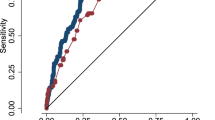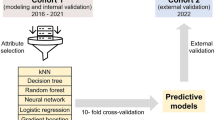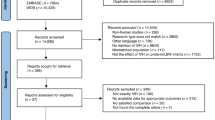Abstract
Objective
To evaluate the impact of elevated supine midline head position on intraventricular hemorrhage (IVH) in very-low-birth-weight (VLBW) infants.
Study design
We reviewed data from four Level III/IV units. Two of these units (mid-line group) cared for infants in midline position and the other two (routine care group) provided routine care. We compared incidence of any and severe IVH in two groups using multivariate logistic regression analyses.
Results
Of 2201 VLBW infants, 1041 were extremely-low-birth-weight (ELBW). Odds of any IVH were not different either for VLBW or ELBW infants. Odds of severe IVH were higher for VLBW infants in mid-line group (OR 1.43, 95% CI 1.007–2.02; p value 0.046) but not for ELBW infants (OR 0.9, 95% CI 0.6–1.4; p value 0.73).
Conclusions
The incidence of any IVH was similar in the two groups but the incidence of severe IVH was higher in VLBW infants in mid-line group.
This is a preview of subscription content, access via your institution
Access options
Subscribe to this journal
Receive 12 print issues and online access
$259.00 per year
only $21.58 per issue
Buy this article
- Purchase on SpringerLink
- Instant access to full article PDF
Prices may be subject to local taxes which are calculated during checkout
Similar content being viewed by others
References
Stoll BJ, Hansen NI, Bell EF, Shankaran S, Laptook AR, Walsh MC. Eunice Kennedy Shriver National Institute of Child Health and Human Development Neonatal Research Network et al. Neonatal outcomes of extremely preterm infants from the NICHD Neonatal Research Network. Pediatrics. 2010;126:443–56.
Patra K, Wilson-Costello D, Taylor HG, Mercuri-Minich N, Hack M. Grades I–II intraventricular hemorrhage in extremely low birth weight infants: effects on neurodevelopment. J Pediatr. 2006;149:169–73.
Bolisetty S, Dhawan A, Abdel-Latif M, Bajuk B, Stack J, Lui K. New South Wales and Australian Capital Territory Neonatal Intensive Care Units’ Data Collection Intraventricular hemorrhage and neurodevelopmental outcomes in extreme preterm infants. Pediatrics. 2014;133:55–62.
Mukerji A, Shah V, Shah PS. Periventricular/intraventricular hemorrhage and neurodevelopmental outcomes: a meta-analysis. Pediatrics. 2015;136:1132–43.
Ment LR, Ådén U, Bauer CR, Bada HS, Carlo WA, Kaiser JR. Gene targets for IVH Study Group and the Neonatal Research Network et al. Genes and environment in neonatal intraventricular hemorrhage. Semin Perinatol. 2015;39:592–603.
Rushing S, Ment LR. Preterm birth: a cost benefit analysis. Semin Perinatol. 2004;28:444–50.
Ballabh P. Pathogenesis and prevention of Intraventricular hemorrhage. Clin Perinatol. 2014;41:47–67.
Shankaran S, Lin A, Maller-Kesselman J, Zhang H, O’Shea TM, Bada HS, et al. Maternal race, demography, and health care disparities impact risk for intraventricular hemorrhage in preterm neonates. J Pediatr. 2014;164:1005–11.
Roberts D, Dalziel S. Antenatal corticosteroids for accelerating fetal lung maturation for women at risk of preterm birth. Cochrane Database Syst Rev. 2006:CD004454.
Smit E, Odd D, Whitelaw A. Postnatal phenobarbital for the prevention of intraventricular haemorrhage in preterm infants. Cochrane Database Syst Rev. 2013;2013:CD001691.
Fowlie PW, Davis PG, McGuire W. Prophylactic intravenous indomethacin for preventing mortality and morbidity in preterm infants. Cochrane Database Syst Rev. 2010;2010:CD000174.
Carteaux P, Cohen H, Check J, George J, McKinley P, Lewis W, et al. Evaluation and development of potentially better practices for the prevention of brain hemorrhage and ischemic brain injury in very low birth weight infants. Pediatrics. 2003;111:e489–96.
Emery J, Peabody J. Head position affects intracranial pressure in newborn infants. J Pediatr. 1983;103:950–3.
Cowan F, Thoresen M. Changes in superior sagittal sinus blood velocities due to postural alterations and pressure on the head of the newborn infant. Pediatrics. 1985;75:1038–47.
Pellicer A, Gaya F, Madero R, Quero J, Cabanas F. Noninvasive continuous monitoring of the effects of the head position on brain hemodynamics in ventilated infants. Pediatrics. 2002;109:434–40.
de Bijl-Marcus KA, Brouwer AJ, de Vries LS, van Wezel-Meijler G. The effect of head positioning and head tilting on the incidence of intraventricular hemorrhage in very preterm infants: a systematic review. Neonatology. 2017;111:267–79.
Romantsik O, Calevo MG, Bruschettini M. Head midline position for preventing the occurrence or extension of germinal matrix-intraventricular hemorrhage in preterm infants. Cochrane Database Syst Rev. 2017;7:CD012362.
Papile LA, Burstein J, Burstein R, Koffler H. Incidence and evolution of subependymal and intraventricular hemorrhage: a study of infants with birth weights less than 1,500 gm. J Pediatr. 1978;92:529–34.
Al-Abdi SY, Nojoom MS, Alshaalan HM, Al-Aamri MA. Pilot-randomized study on intraventricular hemorrhage with midline versus lateral head positions. Saudi Med J. 2011;32:420–1.
Al‐Abdi S, Alallah J, Al Omran A, Al Alwan Q, Al Hashimi H, Haidar S. The risk of intraventricular hemorrhage with flat midline versus flat right lateral head positions: a prematurely terminated multicenter randomized clinical trial. Pediatric Acad Soc. 2015.
Kochan M, Leonardi B, Firestine A, McPadden J, Cobb D, Shah TA, et al. Elevated midline head positioning of extremely low birth weight infants: effects on cardiopulmonary function and the incidence of periventricular-intraventricular hemorrhage. J Perinatol. 2019;39:54–62.
Ancora G, Maranella E, Aceti A, Pierantoni L, Grandi S, Corvaglia L, et al. Effect of posture on brain hemodynamics in preterm newborns not mechanically ventilated. Neonatology. 2010;97:212–7.
Elser HE, Holditch-Davis D, Levy J, Brandon DH. The effects of environmental noise and infant position on cerebral oxygenation. Adv Neonatal Care. 2012;12:S18–S27.
Liao SM, Rao R, Mathur AM. Head position change is not associated with acute changes in bilateral cerebral oxygenation in stable preterm infants during the first 3 days of life. Am J Perinatol. 2015;32:645–52.
Spengler D, Loewe E, Krause MF. Supine vs. prone position with turn of the head does not affect cerebral perfusion and oxygenation in stable preterm infants ≤32 weeks gestational age. Front Physiol. 2018;9:1664.
Malusky S, Donze A. Neutral head positioning in premature infants for intraventricular hemorrhage prevention: an evidence-based review. Neonatal Netw NN. 2011;30:381–96.
Handley SC, Passarella M, Lorch SA, Lee HC. Survey of preterm neuro-centric care practices in California neonatal intensive care units. J Perinatol. 2019;39:256–62.
Jarus T, Bart O, Rabinovich G, Sadeh A, Bloch L, Dolfin T, et al. Effects of prone and supine positions on sleep state and stress responses in preterm infants. Infant Behav Dev. 2011;34:257–63.
Gouna G, Rakza T, Kuissi E, Pennaforte T, Mur S, Storme L. Positioning effects on lung function and breathing pattern in premature newborns. J Pediatr. 2013;162:1133–7.
Rivas-Fernandez M, Roqué I, Figuls M, Diez-Izquierdo A, Escribano J, Balaguer A. Infant position in neonates receiving mechanical ventilation. Cochrane Database Syst Rev. 2016;11:CD003668.
Author information
Authors and Affiliations
Contributions
PK conceptualized and designed the study, coordinated center recruitment and data collection, participated in data analyses, drafted the initial manuscript, and reviewed and revised the manuscript. KFC, PP, AR, and WW helped with data collection and interpretation, and reviewed and revised the manuscript. HW carried out the statistical analyses, and reviewed and revised the manuscript.
Corresponding author
Ethics declarations
Conflict of interest
The authors declare that they have no conflict of interest.
Additional information
Publisher’s note Springer Nature remains neutral with regard to jurisdictional claims in published maps and institutional affiliations.
Rights and permissions
About this article
Cite this article
Kumar, P., Carroll, K.F., Prazad, P. et al. Elevated supine midline head position for prevention of intraventricular hemorrhage in VLBW and ELBW infants: a retrospective multicenter study. J Perinatol 41, 278–285 (2021). https://doi.org/10.1038/s41372-020-00809-6
Received:
Revised:
Accepted:
Published:
Issue date:
DOI: https://doi.org/10.1038/s41372-020-00809-6
This article is cited by
-
A simple scoring system for prediction of IVH in very-low-birth-weight infants
Pediatric Research (2023)



